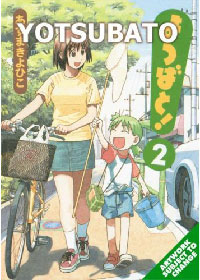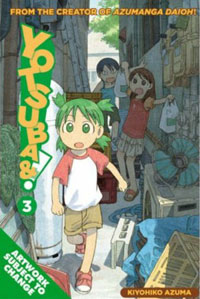 Logo handmade by Bannister
Column by Scott Green
Logo handmade by Bannister
Column by Scott Green
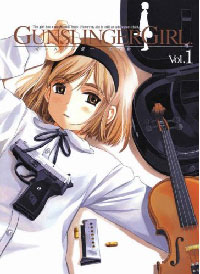
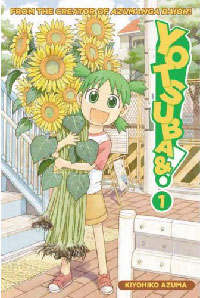
The fourth volumes of Yotsuba &! and Gunslinger Girl will be released in July, a year and a half after the release of the series' previous volumes. Less one think we're back to the dark days after a brief reprieve, Yotsuba &! volume five is listed for October 10th, 2007 and Gunslinger Girl volume 5 is listed for September 5th, 2007. In tone, the pair are day and night. While, Yotsuba is simple and amazingly uplifting, Gunslinger Girl is intensely melancholy. Together, they represent a symbolic return to form from a publisher who has ridden a steep roller-coaster in the distribution of localized Japanese comics in North America. ADV Manga was never really gone. The thriller Anne Freaks, the supernatural, alternative history action Chrono Crusade and absurdist teenage tough-guy comedy Cromartie High were among the titles released with some regularity. In fact Cromartie High was nominated for the 2006 Best U.S. Edition of Foreign Material Eisner Award. Similarly, during this quite period the company introduced a few titles such as the Evangelion recast as high-school dramady "Angelic Days". What did happen was that ADV Manga had 79 announced titles, with 1000 licensed volumes of Japanese manga and Korean manwha, in the height of the 2003-2004 manga boom. After releasing a blitz of first volumes, the manga market hit a severe correction period. Brick and mortar stores could not support the quantity of releases, and distributors were hard hit when outlets such as Musicland declared bankruptcy. The output slowed to a trickle. The post denial-of-manga-attack throttled release schedule was best expressed by the halt of two particularly beloved titles: Yotsuba &! and Gunslinger Girl. 79 titles is a huge amount of manga. Among ADV's list, the company had a few high profile properties including the manga that inspired popular anime, like Gunslinger Girl, and manga from creators with previous, successes like Yotsuba &! Then, there were a few singular, attention grabbing works on the slate. A prime example was the compelling anthropomorphic animal Vietnam War history lesson Apocalypse Meow, originally "Cat Shit One." After these easily spotted winners, there were the quirky, fun diamonds in the rough. The problem was that, with so many releases, these gems were hidden in a deep field. The troubling concern has been that the manga release field found itself littered with abandoned series. Anime hit a market constriction similar to manga's, but for the most part, anime releases ground through until completion. While it is an effort to catalogue all of the MIA manga, anime fans can easily recount the titles like I'll be an Angel that stopped dead. Only recently have the fates of ADV's titles become known, and even then, the information has been revealed indirectly. A few of the winners of ADV's crop, including the graceful sci-fi Aria have since moved to other publishers. For the majority, it is time for the bugle to play Taps. In an interview with Anime News Network, ADV cofounder and CEO said John Ledford The manga market, like anime, is saturated and/or matured, so we're going to be very selective about the manga titles we do in the future. We will continue to buy good manga properties whenever and wherever it makes sense where there's strategy, whether it's tied to home video, or it's just a good manga. But we're not going to take any B or C titles. Everything has to be A+. It's quality over quantity. ... Most of the stuff we'd licensed back in 2003 and 2004 [have] already expired. ... If there are 400 to 500 really avid fans out there that want volume x of title y, well, sorry, but we can't help you; and I don't think anyone else can either. No one will put a product on the market when it's not sustainable. This goes beyond the tension over when it is fair game to stop a flagging manga. A few of us are weeping for the loss of Dark Horse's School Zone, and slightly more tears are shed for Junji Ito's Museum of Terror, but if a series never finds readers or sheds reader, the move to cut losses is understandable. ADV's mass purge of titles is a different case entirely. The manga did not die of lack of consumer support. There's no way to chastise fans, because bulk was simply unsupportable. Doubtless, ADV did not plan to flood the market, then tightly dole out future releases of the great successes. They had to have wanted 79 successful titles rather than a handful. But, when the hard times came, the new release model looked a lot more cynical. Communication has unquestionably aggravated the fan perception of the problem. ADV has run its anime and manga arms differently, and a stark difference has been in their public faces. ADV anime is never able to generate enough talk, whether they've been courting good will, or controversy. With new licenses routinely announced at conventions, the anime devision has cultivated an illusion of transparency with the fans. ADV Manga has been near silent since the implosion. The consumer has not known what titles where coming back or when. Currently, an out of date "complete" list of manga on the corporate site lists 50 Rules For Teenagers All Purpose Cultural Cat Girl Nuku Nuku Azumanga Daioh Chrono Crusade Cromartie High School Full Metal Panic! Full Metal Panic-The Anime Mission Gunslinger Girl Kids Joker Najica Blitz Tactics Orphen Pretear Princess Tutu Quantum Mistake Rahxephon Bible Ray Saint Marie Seven Of Seven Sky Blade: Sword Of The Heavens Sweet & Sensitive Jinki: Extend The site also allows a visitor to check out press releases from 2004 and a release schedule from 2005. There are plenty of people who are thrilled to see Yotsuba &! and Gunslinger Girl return. Perhaps it is reading too much into presumed strategy, but there is something almost suspect in the delayed re-commencement of two titles that are specifically ill-will proof. Fans of these series anticipate the next volume due to their appreciation of what the series have to offer, with little reliance on serialized momentum. An 18 month release interval would kill something like Anne Freaks, a series that is comparable to Death Note. For Yotsuba &! and Gunslinger Girl, the wait could have been twice as long, and fans still would have welcome the series back. Again, the business logic is comprehendible, but it is not exact pleasant from a consumer stand point to see that these are series that can and have been done it on ADV's time frame, expectations be damned. At the end of the day, it's no consolation that the unpleasant wait to purchase the next volume of these manga titles has to be a shadow of the rocky affair endured by those inside ADV's manga production department. Except, had their been better communication in the down time, with fans knowing what is dead and when the returning series would be back, the rebound could have been embraced more amicably.
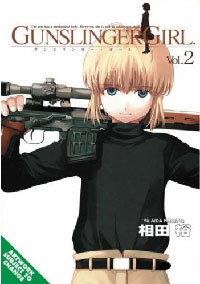
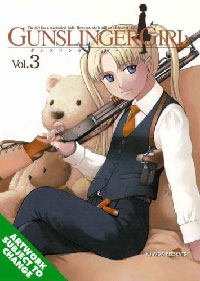
Gunslinger Girl By Yu Aida Volume 4 To be Released by ADV Manga July 2007
To further grind down the shock value of the phrase of the day, Gunslinger Girl is not "torture porn", though it does have references to a child torture ring where "fingernails are removed. bones are broken. fingertips are cut off." Instead, the manga aims to be tragedy porn. It's child assassins again. The tag line over the image of bespectacled girl lowering her open copy of Puccini's Tosca in order to contemplate the opera, with a pistol holster draped over her bookshelf, is "The girl has a mechanical body. However, she is sill an adolescent girl." Gunslinger Girl wants to make the too familiar child-killer concept shockingly dark. In place of acrobatic death dealing, the manga takes the self-evident notion that killer children is an idea that is terribly wrong, and constructs a series of vignettes illustrating the physical and emotional toll on people turned into tools, as well as the reflective damage to those involved in the process. This time the child assassins are produced by an overreaching governmental initiative, as in Le Femme Nikita, Bourne Identity or the like. Italy's "Social Welfare Agency" takes in pre-pubescent girls whose bodies have been ravaged, in most cases by unspeakable crimes. Their bodies are cybernatically reconstructed. Their brains are rewired with a conditioning program that, among other instructions, ensures to-the-death-loyalty to the girl's adult, male handler. Then the "fratello" pair of girl and handler are deployed for field work, tangling terrorist targets and major crimes when the situation gets hot. Picking up Gunslinger Girl after its extended absence is not entirely a smooth re-introduction. There is some continuity to the manga, and its early chapters do refer to previous events. However, despite some ongoing conflict, the way it progresses with its characters is almost set up like a slice of life work. It's depicting a pathologically constructed life, but the small increments of character advance, and defining flashbacks suggest the pattern of a smaller, less exaggerated work. However, the defining characteristic of Gunslinger Girl is that while the series' tone gets nowhere near pulp reckless abandon, it does heap an incomparable amount of woe on top of its characters. In the case of Gunslinger Girl, there is a lingering impression that it isn't dealing with the gravity of the subject matter honestly. If Gunslinger Girl simply, just fed its characters into the proverbial wood-chipper the way that something like Kite does, the manga would present a simple "take it or leave it" upfront proposition. Instead Gunslinger Girl makes attributing what's wrong or distasteful to what is being portrayed versus how it is being portrayed difficult. Evil things being done to children is a touchy subject, but classic manga is full of grievous wrongs done to children. Even in Tezuka's works, wrongs done to children have been graphically depicted. His Ode to Kirihito features an infant being fed to a snake to entertain a wealthy man. Kazuo Umezu's Drifting Classroom is a catalogue of children dying in gruesome manners, from jumping off a roof top to being eaten to the bone, alive, by insects. What's troubling in Gunslinger Girl is how narrow the scope is. The manga is simply interested in the cuteness of adolescent girls living normal lives and the sorrow of those girls turned into front-line agents. The drama of Gunslinger Girl is not positioned to be instructive, This is not Now and Then, Here and There. While it touches on real government conflicts and grounds itself in real locations, suggested with attention to visual detail, it exists in its own reality. Despite the context and despite the attempts to ground the military work and violence in reality, these mind-wiped cyborg soldiers do not suggest a parallel to real child conscription or child exploitation, even on a metaphorical level. The limits of how far Gunslinger Girl wants to take the situation become more evident as it demonstrates that it wants to have its cake and eat it too. Even if there is little on-panel snuff, and it avoids crossing the boundary into real believability, it does produce some severed limbs, and it is frequently grave enough to be deeply disquieting. At the same time,it wants the cute moments of a cherubic faced girl getting her cheek pinched and it wants the innocent moments of a girl intently working in a garden. This isn't cute in the abstract sense of Hello Kitty or in the manner of super deformed character design. The brand of fascination with innocence and particularly an idealized notion of young, female innocence is referred to as moe. Gunslinger Girl is deeply moe and, at same time, it looks to violate the principles of moe. It intends for there to be significance in the symbolism of the moment of the cheek being pinch or the garden planting, and it intends for their to be a powerful sense of loss. Unfortunately, it is not deconstructing the cuteness the way something like Junko Mizuno's work might, or even commenting on its obliteration. It simply calls attention to the consequence of shattering moe, while leering at the pathos. And Aida is quite skilled in this respect. The manga is often beautiful, and when it captures the coast of Naples, a classic Italian plaza or the interior of an opera house, the manga has the air of a specific exotic location and it looks far more interesting thanks to this locale. For the characters, Aida captures the look of middle-school aged children in way that is more doll like than either the cartoon action hero look of shonen manga or the emotive look of shoujo. This approach focuses on an angelic face and calls attention to the clothing. Aida can dynamically reposition the forms for action sequences, but the points of focus remain the same. A squad of girls with be fielded, armed with realistically rendered guns and they'll still be well dressed for the outing. From a plot perspective,the mundane routines, the art appreciation and the fashion are masking agents for a deeply disturbing crime against humanity. The handlers are treating these girls as living dolls. Externally, there is little difference in how the manga itself is treating the characters. If what the handlers are doing is at least misguided, maybe the same could be said of the manga. If the manga is not relevant, it doesn't put on airs that it thinks it is. A saving grace is that the tone of the manga does not suggest self satisfaction or moral superiority. While the depicted stories do have a moral component, the manga itself is apolitical. It would have been insufferable if it chastised the reader for their interest in the subject matter in which it steeps itself.Yotsuba &! Volume 4 by Kiyohiko Azuma To be released by ADV Manga July 2007
You have to be inhuman not to love Yotsuba &! At worst, Kiyohiko Azuma's work can suggest some regressiveness, but Azuma also holds the crown for feel good manga. His eponymous Azumanga Daioh was a nostalgic distillation of the untroubled moments of student life. Yotsuba &! goes back a lot further, to the point after a child's personality has started to really become demonstrative. The results are akin to time spent with a delightful child who isn't your own, isn't related, isn't a godchild and isn't going to make you participate in a Disney princesses board game. As with Azumanga Daioh, there is a bittersweet quality in the concrete notion of time passing, with a certainty that the freer days of youth are ephemeral. Yet, there's no dark cloud to the manga, simply fun with human social interaction and human nature. "Yotsuba" can mean "four leaves", which is an appropriate name for the main child, whose green hair is tied into four tufts on the corners of her head. This five year old native of an island "to the left" was an orphan adopted by the young bachelor translator Koiwai. Despite the green hair and the out of the ordinary origin, the manga relies on a believable sense of reality. Rather than a gimmick or a story conceit, Yotsuba &! aims to recapture the excitability of youth. While the character more or less acts her age, she almost functions like a tiny version of Seinfeld's Kramer. Half of the joke is her physical reaction to experience. Rather than stumble through the doorway, she lights up like a lamp every time she encounters something outside of her understanding, which is frequent considering that she is unfamiliar with many of the trivial things taken for granted. During volume four, she charges up to a neighbor and finds that the teenager is heart broken because the object of the neighbor's infatuation would not return her affection. Seeing the heart broken teenager, Yotsuba's beacon eyes go blank, and she begins panicking. As the two talk, Yotsuba bounces between flailing arms excitement and hollowed out tearfulness. Yotsuba leaves with the secret, which presents an opportunity to demonstrate the other side of her Kramer-ian humor: trampling social morays, particular in regarding tactfulness. Yotsuba charges off, alterts the girl's older sister and mother, then, with some mischievous prompting, informs the girl that she has fat thighs, and that her older sister never had to be heart broken. Though Yotsuba is a young character, the appeal of the manga is targeted for a slightly older, male audience. It ran in the anthology Dengeki Daioh along with Gunslinger Girl and other seinen titles that at first glance might seem intended for other audiences, that are younger or female. In addition to Azumanga Daioh, these titles include Strawberry Marshmallow, Kasimasi ~Girl Meets Girl~, Di Gi Charat, and Kamichu. As with Azumanga Daioh, Azuma is exceptionally light on the ogling aspect of what appears in Dengeki Daioh. The manga is idealized to the extent that Yotsuba is able to wonder around without any real concern. This free sthe manga not to have to create exceptional situations for its subject. Basically, she can walk down the street, discover, swings or a sport, or go tho the supermarket, and given her reactions, the excursions become a satisfying, charming experience. Similarly, the flaws demonstrated reflect the lighter side of human nature. Yotsuba is not a problem child and not malicious. However, she does exercise the human impulse to duck blame. After kicking a soccer ball through the window, she doesn't miss a beat asking "who did that?" In addition to the physical humor of a legitimately adorably design character, there is a naughty charge on the part of older readers appreciating the extent to which this little girl can agitate those around her simply by acting naturally. Lesser Yotsuba &! is still delightful, and volume 4 is lesser Yotsuba &! Throughout the volume, Yotsuba still haunts her neighbors, and over-literalizes information, and her energy is still day-glow radioactive. In volume three, Azuma was getting the peak output from the concept. Yotsuba's memorable experiences, such as her first trip to the zoo or encounter with fireworks, become memorable for the reader. In cases like this, Azuma establishes the sense of wonder by setting his iconic design against more concrete backdrops, without establishing a noticeable border between the difference in style. He then peppers the volume with stand out gags, filling each story with at least a couple of winners. Where as you can easily lose yourself thumbing through previous volumes again, the population of laugh out loud Yotsuba-isms in volume four is far sparsre. Nor is the volume helped by one of the series first real failures for a chapter story concept. Yotsuba's father's buddy "Jumbo", so named for his exceptional height, takes the crew on a fishing trip. The friend of the youngest of three sisters who live next to Yotsuba remarked off hand that her family had no plans for summer break because her father would be working the whole time. Imagining that the girl would be heart broken, Jumbo packs everyone up for an excursion. There might be a theme about an adult attempt to forcibly create a memorable experience, but the children are oblivious and the falseness is overly apparent to the read. Yotsuba, Koiwai, Jumbo, the neighbor and her friend go to a fishing hole. At the bait shop, they purchase fish, which are used to stock the fishing hole, literally stocked right in front of them. With the venture ending with Jumbo berating a kid for not living up to his false notion, the ironic thrust of the story seems contrary to the spirit of Yotsuba &! Not only does it lack the air of something special, Yotsuba is unfortunately marginalized in her own title. Occasionally the story will look to her to a catch a reaction shot, but these are obvious, and she offers little other than her face faults. Yotsuba's imaginative miscomprehension does yield at least one particularly charming joke, and that is good enough to make the venture worth while. ADV's adaptation of the manga gracefully handles its Japanese aspects. The manga has been flowing through the seasons, with this volume dedicated to summer. Yosuba is told that the noise produced by the cicada insects signals the end of summer. And of course, according to Yotsuba, after summer comes her favorite season, spring. She is particularly enthralled by the tsuku-tsuku-boshi, a species of cicada named for the sound that it produces. Boshi is a homonym for the Japanese word for "cap", so Yotsuba assumes that these creatures are tiny fairies that wear triangular hats. So, as the sumer wears on, after trying to stop global warming by shutting down the air conditioner, she decides to take on the tsuku-tsuku-boshi role and end summer herself.For more commentary see the AICN Anime MySpace and AICN Anime on ComicSpace.

